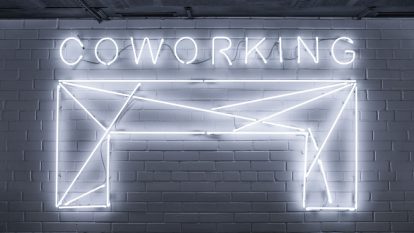

The kind of workplace that WeWork has had a huge hand in creating – one whose set-up, ethos and aesthetic has influenced not only other shared spaces, but thousands of private companies’ offices – can easily translate into living and education spaces. Already, there’s a clear aesthetic shared between WeWork and other ‘third spaces,’ from consultancy HQs to Starbucks, which identify above all as social places of growth.
WeWork and others reflect a new truth that the real ‘workplace’ of the 21st century is the screen. That’s where knowledge-economy, flexible century workers complete the vast majority of their billable hours, where they concentrate and produce by being focussed on their computers to the exclusion of all else. Even if you’re employed at an office by a single employer, you’ll probably have heard a colleague say, ‘Sorry I missed seeing you yesterday – I just had so much piling up, I worked from home, so I could really get it done.’
Because the “real work” takes place virtually, the new “point” of offices is to act as the third space between leisure and “work work”, to offer a place to connect. Offices are for meetings, serendipitous chats, inspiring others and being inspired – and we see this evolution mirrored semiotically in office design.
Over the years, the innovative office ideal has moved from the clean open spaces of the ‘90s, to the bright playful playgrounds of the ‘00s, to the subtle, natural-looking design, with wood tones and yellowish lighting, which unites WeWorks, Starbucks and other growth spaces. This isn’t out-and-out sociability that crosses into play or family/ friend time, the ‘non-work’ self – rather, these are unfinished-looking areas where employees and freelancers alike can grow organic connections and new ideas.
For freelancers and for the ‘intrapreneurs’ who make things happen in companies, human connections are everything. Dating-style networking apps (e.g. Bumble Bizz or Shapr), and co-living communities such as China’s You+, show just how important connection is not just to freelancers, but to all of us.
A freelancer who socialises with clients has a better chance of being hired again. People from different parts of an industry might come together to provide clients with a collaborative offer. Two friends from the same industry putting their heads together can spark an idea for a brand-new company or a sustainable grid that takes care of and protects each other.
And in the last couple of years, these connections have also directly empowered those within them. New networks have sprung up, not only to help people collaborate on projects or ideas, but to help them to make sure they’re being paid, listened to and treated well.
Space Doctors predicted a move towards bottom-up collaboration between workers, partly based on the openly-networked spaces (like Starbucks and WeWork) which people are choosing to work in. The media industry, in particular, is seeing a flurry of freelancers’ and contractors’ unions spring up, and recently, even Google – the prime dominant example of a ‘modern, innovative office’ is experiencing pushback against its strong company-culture-focussed mission. Googlers killed the company’s collaboration with the Pentagon, Project Maven, by rebelling on ethical grounds, and walked out across the world on 1st November 2018 to protest sexual harassment.
The “emergent-emergent” model of work in the future will focus on bottom-up collaboration between workers, freelancers and hybrid workers – and the workplaces of the future may be very different.
For instance, recently, the “Digua” creative community in Beijing has reclaimed many of the city’s unused Cold War underground bunkers, turning them into their own co-working spaces, libraries or communal creches. This is a community with a purpose – to help each other be the best they can be in a challenging city.
This fascinating development shows how a co-working space can be as small as a living-room, and as easy to organise as a Meetup page. A group of people with shared work interests, from a generation which has always been short on money, may well come to see co-created communal spaces as a healthy alternative to paying a monthly premium to a WeWork.
What does this mean for your business, especially if you are a legacy organisation coping with the cultural changes?
Even if you don’t employ freelancers, a huge and influential number of professionals now spend formative parts of their careers freelancing, and many of them will be represented among the Millennials in your office. We can see this expressed in interior design influence, as big multinational companies copy design elements from co-working spaces.
Co-work culture is becoming so dominant that it affects employees’ expectations, attitudes and behaviours, impacting internal culture, space design and work styles. HR handbooks need to provide for the various uncertainties employees experience and cause while moving flexibly between screen (which can be anywhere in the world), office ‘third space,’ and transient locations in between.
Meanwhile, companies catering to SME and start-ups need to design propositions that bear in mind this fluidity of personnel and working styles. For example, insurance providers can consider the evolving health issues related to screen time, and software providers can think about how to replicate the energy of an in-person meeting over video call.
[su_divider top=”no” divider_color=”#f2f2f2″ size=”2″ margin=”40″]